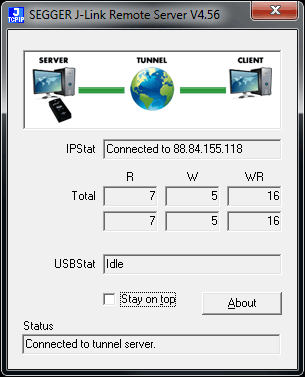SEGGER News
Welcome to the News section, your hub for the latest updates and insights from SEGGER.

Free Remote Debugging Tool for J-Link
The PC (Server) hosting the connected J-Link and target hardware needs nothing more; no need of an expensive IDE license or production flash programming software. All that is required is a running instance of the SEGGER J-Link Remote Server in Tunnel Mode. Once the JLink is connected, the SEGGER Tunnel Server (Tunnel) offers up the J-Link for a remote debugging session. The user of the remote PC (Client) may then connect via the Tunnel Server to the desired J-Link and target hardware. From the engineers perspective, it is as if the hardware is on their desk.
The host site does not gain access to any proprietary or intellectual property controlled code which would typically require lengthy Non-Disclosure Agreements (NDAs) and legal interaction to facilitate such a project. Even with the correct legal paperwork in place, considerable issues are often encountered as the proper tools and the best engineer to accomplish the work may not be available at the hardware site.
“With companies offering their services across borders, it becomes an increasingly important task to find affordable ways for developing and supporting products by international teams. We have used the Tunnel Server ourselves with great success when we work with silicon vendors to implement and test J-Link support at the very early stages”, says Alexander Gruener, marketing manager of SEGGER.
Starting the J-Link Remote Server in Tunnel Mode triggers the Remote Server to connect with the Tunnel Server from SEGGER. The Remote Server registers the serial number of the locally connected J-Link at the Tunnel Server. Now the Tunnel Server is able to provide access to this J-Link via the Internet using its serial number.
When a debugger or any other tool using the J-Link DLL connects with the Tunnel Server and requests a connection to this serial number, the Tunnel Server establishes the connection by forwarding the messages from the J-Link DLL to the Remote Server and vice versa.
More information about J-Link Remote Server and the Tunnel Mode.
About J-Link
The SEGGER J-Link is the most popular debug probe on the market. It is tool chain independent and works with free GDB-based tool chains such as emIDE and Eclipse, as well as commercial IDEs from: Microchip (MPLAB® X), Atmel, Atollic, Coocox, Cosmic, Freescale, IAR, KEIL, Mentor Graphics, Python, Rowley, Renesas, Tasking and others. With the J-Link family, investments in the debug probe are preserved when changing compiler or even CPU architecture.
J-Link supports multiple CPU families, such as ARM 7, 9, 11, Cortex-M0, M0+, M1, M3, M4, R4, A5, A8, A9 as well as Renesas RX100, RX200, RX610, 620, 62N, 62T, 630, 631, 63N and Microchip PIC32; there is no need to buy a new J-Link or new license when switching to a different yet supported CPU family or tool-chain. SEGGER is also continuously adding support for additional cores, which in most cases, only requires a software/firmware update. Unlimited free updates are included with even the baseline model of the J-Link family. SEGGER is excited to continue advanced development of its cutting edge embedded tool solutions to be utilized with pretty much any development environment you choose. All J-Links are fully compatible to each other, so an upgrade from a lower-end model to a higher-end model is a matter of a simple plug-and-play.
Full product specifications are available at: www.segger.com/jlink.html The J-Link-Software is available at: www.segger.com/download_jlink.html U.S. On-Line Web Shop: http://shop-us.segger.com Online Shop (Europe, Asia, Africa): http://shop.segger.com